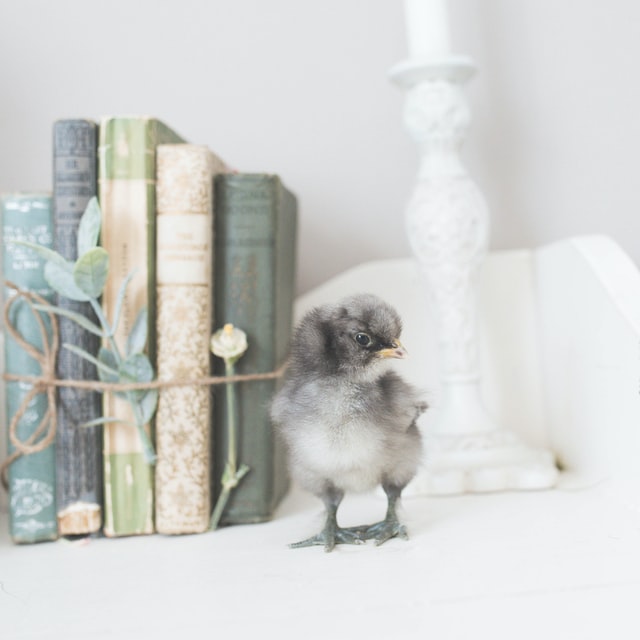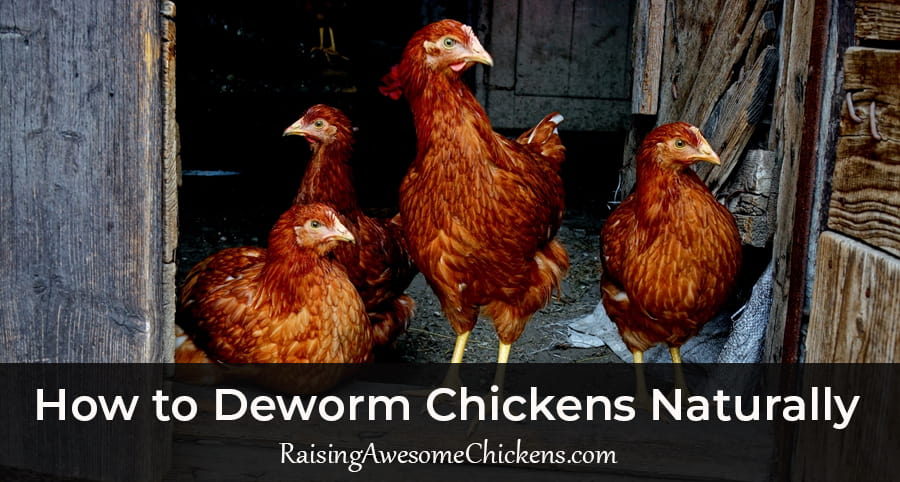Last Updated on March 1, 2024 by AwesomeChickens
Table of Contents
Understanding the Dynamics of Multi-Species Co-Habitation
Cats and chickens are common pets that can be found in a variety of settings, from rural farms to urban homesteads. They each play distinct roles in their environments but can they exist together? Cats, known for their independence and hunting skills, often serve as pest control, keeping mouse and rat populations under control. On the other hand, chickens are primarily kept for their ability to produce eggs and, for some, meat.
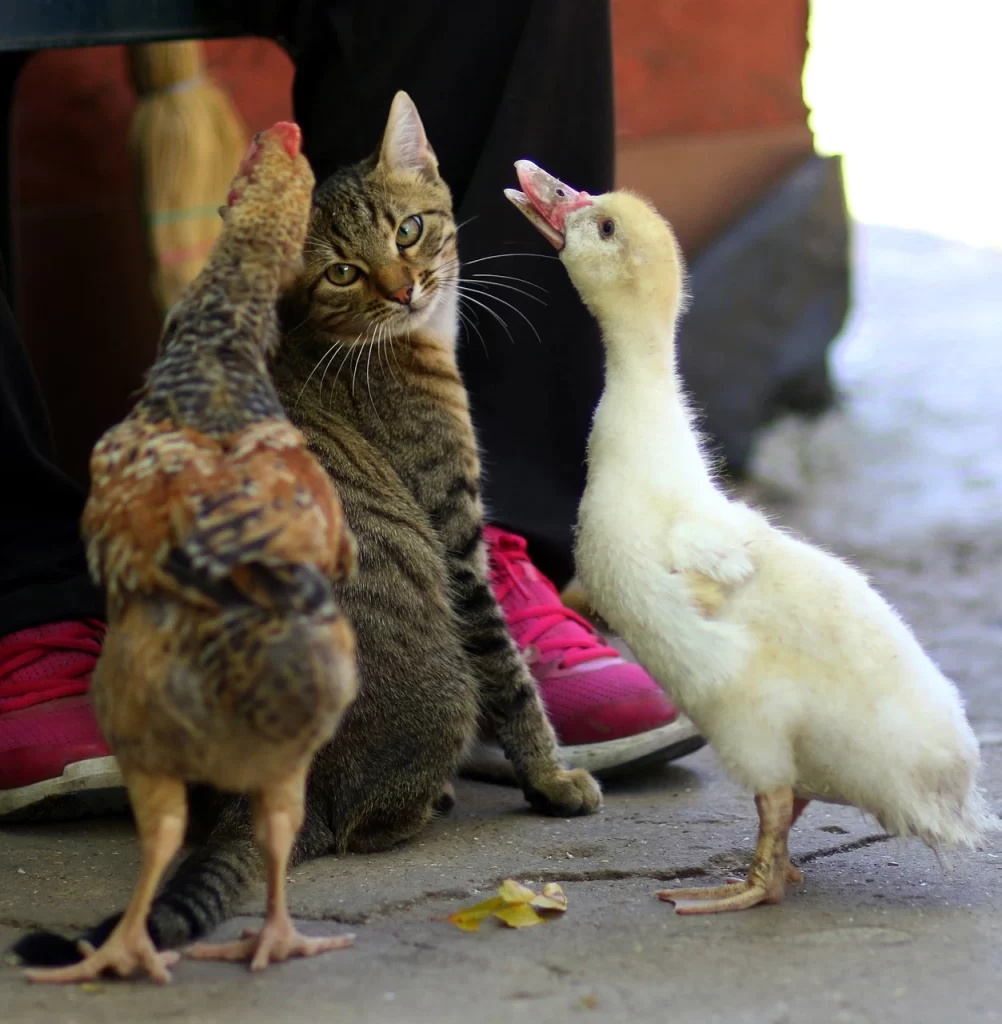
While both are domesticated animals, their interactions are not always harmonious. Cats are naturally predatory animals and may view chickens, especially smaller or young ones, as potential prey. As a result, owners must take precautionary measures if they are to cohabitate. This involves careful introductions, supervision, and ensuring that chickens have a safe and secure environment to retreat to.
Understanding the behaviors and needs of both cats and chickens is crucial for creating a peaceful coexistence. Training and environmental enrichment can greatly reduce the risk of predatory behavior in cats, while providing chickens with ample space can help maintain their well-being. The key lies in balancing the natural instincts of cats with the vulnerability of chickens, fostering an arrangement that benefits the homestead or household as a whole.
Understanding Behaviors and Instincts
This section examines the natural behaviors of cats and chickens and the dynamics of their interactions, providing guidance on maintaining a safe environment for both.
Feline Predatory Instincts
Cats possess a strong predatory instinct that drives them to hunt and pounce on prey. Even domestic cats, which may not need to hunt for food, often exhibit these behaviors during play. It’s a natural part of a cat’s behavior, deeply ingrained in their psyche, whether they are feral or a pampered pet.
Chicken Survival Strategies
Chickens have evolved a range of survival strategies to detect and escape from predators. They are vigilant and quick to react to threats, often taking refuge by flying short distances or retreating behind a fence or into a coop. Roosters also play a protective role, alerting the flock to danger with distinctive calls.
Inter-species Interactions
When cats and chickens interact, their instincts can lead to a range of behaviors. Cats may display curiosity and playfulness, which could be misinterpreted by chickens as a threat, causing them to become defensive. Conversely, cats may react with predatory behavior like hissing or pouncing, or they might remain unphased by the chickens’ presence.
Ensuring Safety for Chickens and Cats
To ensure safety, chickens should be provided with a secured enclosure that protects them from potential harm. This is vital especially where cats are concerned, as even supervised interactions can lead to unpredictable behavior. A secure fence around the coop should be high enough to prevent cats from jumping over.
Symptoms and Preventive Measures for Diseases
Both cats and chickens are susceptible to various diseases. Common symptoms in chickens include fever and lethargy, which could indicate infections like salmonella. Cats can also contract diseases from chickens or from the environment. Preventive measures include regular health checks, proper hygiene, and secured coops to prevent the spread of diseases.
Best Practices for Coexistence
Creating a harmonious environment for cats and chickens involves careful planning to ensure safety for both species. It’s crucial to have designated areas to limit interactions and set routines for feeding and training to prevent conflicts.
Designing a Safe Environment
A sturdy fence with wire mesh is fundamental to protect chickens from potential predators, including cats. An enclosure or shed for chickens that is secure and fitted with wire mesh doors prevents cats from entering. The enclosure should offer protection from the elements and maintain a comfortable temperature. For the safety of both cats and chickens, a solid barn structure can provide shelter and a segregated space that is especially important for raising baby chickens.
- Protection: Install a wire mesh fence around the chicken area.
- Temperature: Ensure the chicken shed maintains a stable temperature.
- Door: Fit doors with wire mesh to keep cats out while allowing visibility.
Training and Supervision
Introducing cats to chickens should be done with supervised, gradual face-to-face introductions to gauge and control their reactions. Start with short, controlled sessions and increase them as animals become more accustomed to one another. Training cats to respond to commands and using distractions can help maintain order.
- Supervision: Always supervise initial meetings.
- Control: Train cats to obey commands to ensure they can be controlled around chickens.
- Reactions: Monitor and manage the reactions from both cats and chickens during introductions.
Feeding Management
Separate feeding areas are essential to prevent competition over food. Cats should not have access to chicken feed, as it’s not suitable for them and may encourage predation on chicks. Conversely, chickens should not have access to cat food. When raising baby chickens, heightened measures should be taken to keep their food and the baby chicks themselves away from cats. Feeding should follow a consistent schedule to avoid any unnecessary stress or conflict.
- Food: Provide separate feeding stations for both animals.
- Chicken Feed: Keep chicken feed inaccessible to cats, especially when feeding free-range chickens.
- Chicks: Protect baby chicks from cats, particularly during feeding times.
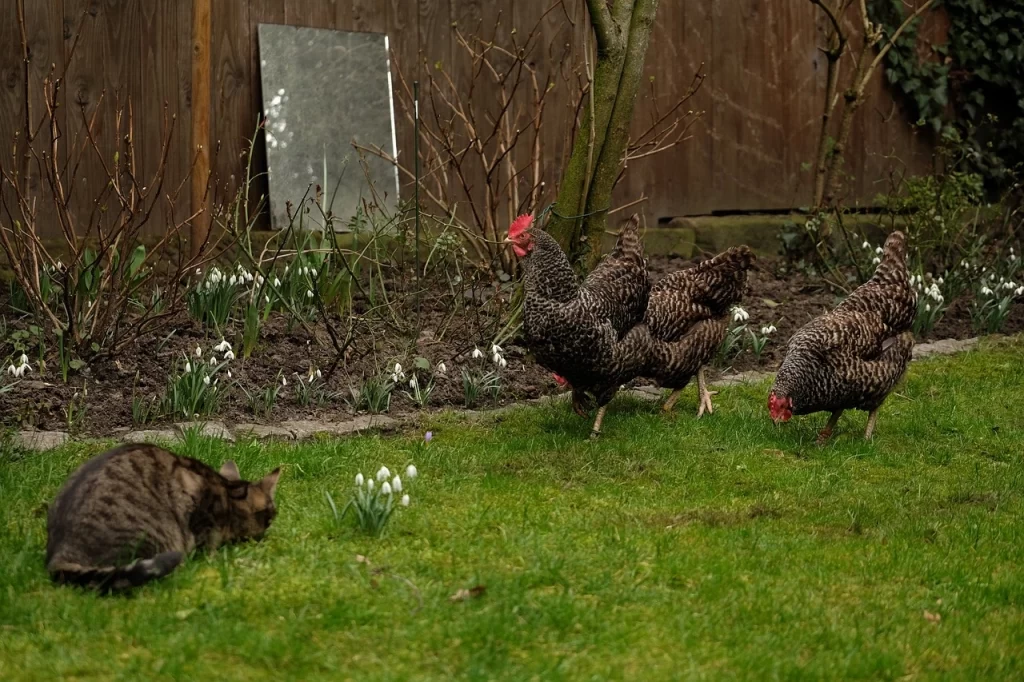
Protection Against Common Threats
When dealing with the well-being of these two species, the management of potential threats is essential. By understanding the interaction with predators and the handling of injuries and diseases, owners can better protect their animals.
Interaction with Predators
Cats, especially feral ones, possess predatory instincts that can pose a threat to smaller creatures, such as baby chickens. To minimize risks, it’s crucial to:
- Introduce: Gradually introduce cats to chickens under close supervision to foster a peaceful coexistence.
- Habitat Security: Enhance coop security to safeguard grown chickens, using sturdy materials that prevent predators from entering.
Predators, including snakes and vermin such as rats and mice, are attracted to chicken coops for both the birds and their feed. Deterring these predators involves:
- Tidy Environment: Keep the coop area clean to reduce attracting vermin.
- Barriers: Employ fine mesh and seal any gaps to thwart snake entry.
- Deterrents: Utilize natural deterrents or traps for vermin, ensuring they are safe for both species.
Managing Injuries and Diseases
Injuries, often resulting from a bite or scratch, can lead to serious infections if not addressed promptly. Prevention and management of injuries should include:
- Inspection: Regularly check cats and chickens for any signs of injury.
- Separation: Keep injured animals separated to prevent further harm and monitor for signs of disease.
Disease prevention is vital for the health of cats and chickens. Key strategies are:
- Vaccination: Ensure timely vaccinations for both species.
- Hygiene: Maintain cleanliness in living areas to reduce disease spread.
- Pest Control: Regularly control pests that can carry diseases affecting both animals.
By adhering to these methods, the safety and health of both cats and chickens can be more effectively managed.
Responsible Ownership and Animal Welfare
Responsible ownership of domestic cats and backyard chickens involves understanding their specific needs and behaviors to ensure their wellbeing.
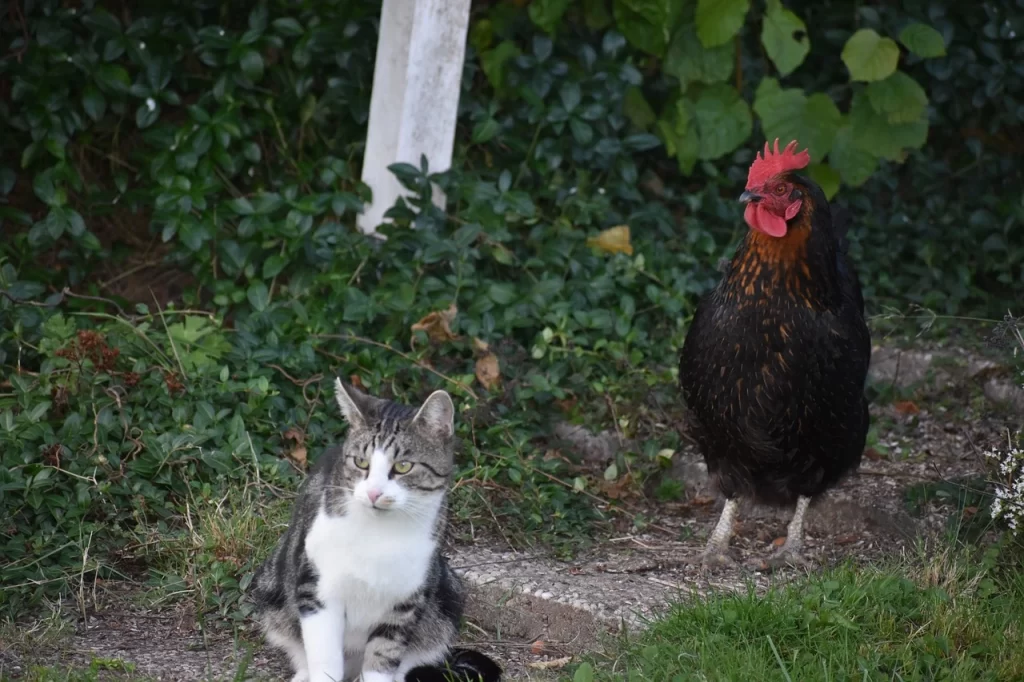
Raising Healthy Flocks and Pets
For backyard flocks, protecting chickens from predators is essential. Shelter, proper nutrition, and space for exercise are paramount. For domestic pets like cats, regular veterinary care and a suitable diet are fundamental. Owners can refer to resources such as Catster, noting that they may receive affiliate commission for promoted products. Regular check-ups and vaccinations help prevent diseases that may affect the health of both.
Understanding Natural Behaviors
Cats display behaviors such as hissing and using their claws to communicate and interact with their environment. Likewise, chickens use their beaks and scratch the ground to forage. Owners should provide opportunities for such natural behaviors to be expressed in safe, controlled settings. Scratch posts and toys for cats and spacious, secure scratching areas for chickens are recommended.
Mitigating Unwanted Behaviors
Training pets to control reactions to stimuli can help mitigate unwanted behaviors. Techniques to train cats not to prey on backyard chickens can include supervised introductions and positive reinforcement to encourage peaceful coexistence. It is advisable not to leave cats and chickens unsupervised together, as the predatory instinct in cats may lead to harm for the flock. Similarly, introducing a rooster to a backyard flock can sometimes lead to aggressive behavior, and owners will need to manage the dynamics carefully to ensure the welfare of all birds.

